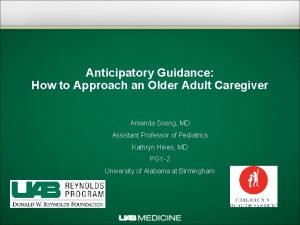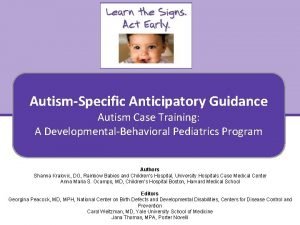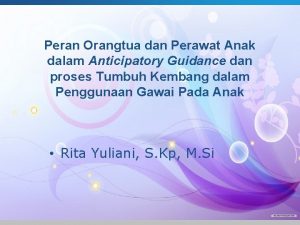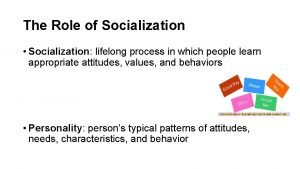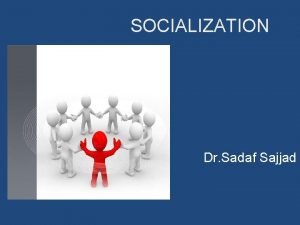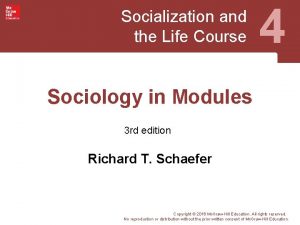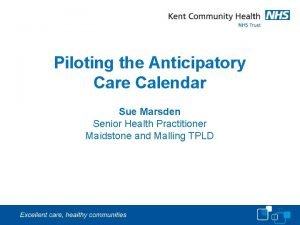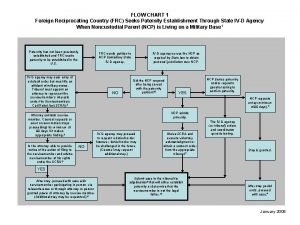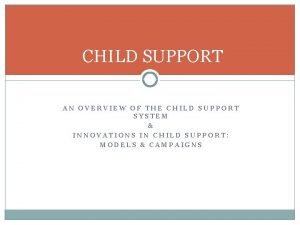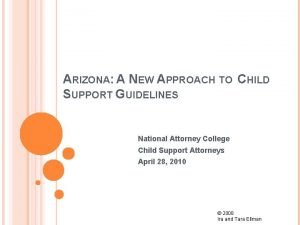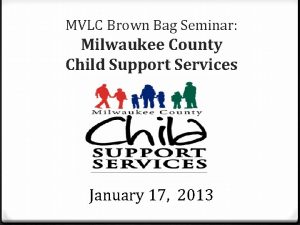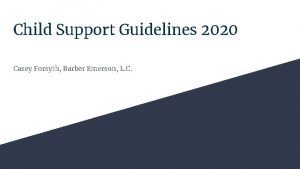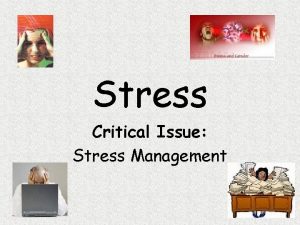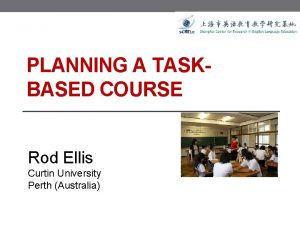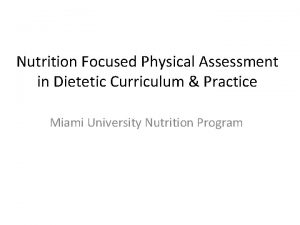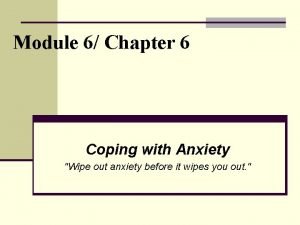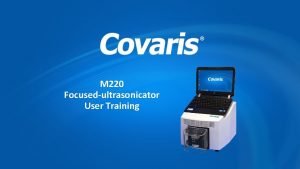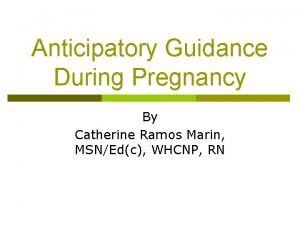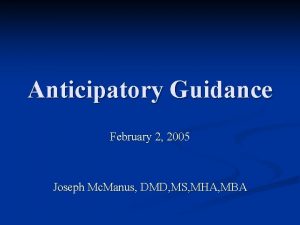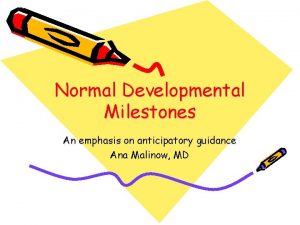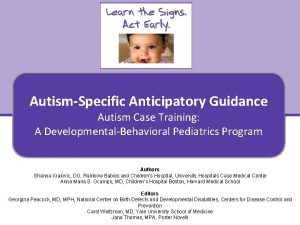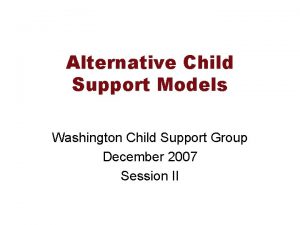Focused Anticipatory Guidance to Support Child Development in













































- Slides: 45

Focused Anticipatory Guidance to Support Child Development in Infants with Risks of ACEs 14 February 2018 Andrew Hsi, MD, MPH Departments of Family and Community Medicine And Pediatrics Director of FOCUS and ADOBE Programs

Cheryl Starts Prenatal Care • • Home pregnancy test positive Presents to primary care for start of care Dating ultrasound shows 17 weeks History includes unplanned pregnancy Smokes 5 cigarettes per day Smokes marijuana daily Smoked heroin, started on Subutex Father not involved, unemployed

Objectives for Presentation Distinguished audience will be conversant in; • Impact of drug use on fetal brain development • Alterations of fetal brains affecting learning • Anticipatory guidance to support learning • Anticipatory guidance for expressive language • Focused developmental support of infants exposed to parental ACEs

Cheryl Delivers Full Term Female Infant, Loretta • L&D issues – Meconium in amniotic fluid – Initial respiratory distress • Important preparations ready – Team anticipates stressed delivery – Stabilization for MBU admission • NICU after transition if needed • Cheryl’s UDM positive – Methamphetamine, THC, buprenorphine 4

Loretta at risk for NOWS • Identification of long opioid exposure • Loretta rooms in with Cheryl – MBU nurses start ESC protocol – Discuss breastfeeding (Crystal’s UDM) – No morphine required • Stabilize medical conditions • Prepare family for discharge • Anticipate developmental follow up 5

Goals of Loretta’s Treatment for NOWS in MBU • Support vital infant functions and development – Hydration, appropriate feeding, normal growth – Sleep regulation for age – Reasonable comfort, not sedation, adjustment of morphine – Socialization; appropriate responsiveness to caregivers • Avoid medical and social complications – Seizures, the endpoint of NOWS (rule out infantile seizures) – Skin breakdown; chemical diaper dermatitis – Nutritional (over feed) and sleep disturbances (bedside contact – Marginalization of maternal contact, social supports – Setting mother up for failure by biased care 6

Risks of Early Developmental Delays for Loretta After Hospital • NOWS clinically reflects lack of cortical inhibition • Scoring fails to evaluate newborn states – Greatest impact is decrease in “quiet-alert” state – Increases “deep sleep” or “active crying” • Reduction of auto-stimulation by swaddling – When cue appropriate; assists cortical inhibition – Helps support infant calming, facilitates learning – Requires committed caregivers 7

Comparative Brain Growth and Effects on Early and Later Development Expression of opiate and dopamine receptors cingulumneurosciences. org

Overview of Developmental Issues; Opioid Exposure • Developmental problems; variable presentation – Most infants have increased neuromotor tone • Jitteriness • Hypertonia trunk, arms flexed, legs extended • Unintentional rolling from side to side – Most have expressive language delays • • Possible effects on brains and inhibition Probable language environment in home Possible untreated fluid in ears Smoke in home environment

Longer Term Development After Prenatal Opioid Exposure • Do children with exposure compared to children in a comparison group (Nygaard E, et al Pediatr Res. 2015) – Catch up, – Remain at disadvantage, or – Have further decrease in function over time • What are challenges in answering these questions? – Comparable population – Extent of opioid exposure – Home environment around children – Other illnesses, nutrition, community environment 10

Norwegian Cohort Follow Up • Followed from age 1 to 8 ½, 72 exposed, 58 without known risks • Findings on cognitive abilities between groups: – Difference in cognitive abilities not reduced over time – Lower functioning emerged later for girls in exposed group – Group difference in cognitive abilities at 8 years • Highly significant even with better earlier cognitive abilities • Indicate continuous negative processes in children with exposure • Same findings for sub-sample who moved to stable foster/adoption homes before 1 year. 11

Another Naturalistic Study Proving What Has Been Shown Over 20 Years • So now what? – Research funded Brave New World scenario; alphas versus deltas – Economy of present driven by information not production • Observation about lives of parents in FOCUS – Life experience included multiple trauma events – Lived in homes without supportive parenting models – Their problems observed by systems; health, social, education – No or minimal intervention by systems for children 12

Birth Accelerates Loretta’s Learning and Starts Opportunities for Interventions • • • Cheryl takes bus to hospital Stays with Loretta every night CYFD investigates Cheryl takes Loretta home No major medical issues Melinda referred to program News. discovery. com

Synaptic Structures at Birth Elaborate More Numbers and Density of Connections Loretta’s brain when sent home Humans achieve 75% of adult brain size by age 2

The Science; Humans are Born Learning • From minutes old – Earliest forms of social imitation is how babies use the emotions and actions of others to inform what they themselves do – Infants are learning every minute, in every interaction • Infants alter their actions based on the emotions that they observe between other people • Early good emotional connections essential for learning • Urban myth; we use 10% of our brains

Loretta at 4 Months • Missed earlier appointments • Comes to clinic with Cheryl • Concerns are; – Loretta’s crying – Waking up often to eat – How should we play with her? • Loretta’s growth normal, vitals normal • Appointment time 20 minutes

4 Month Bright Futures Developmental Screening

Handout Topic for Parents

Anticipating Next Visit

Group Exercise • Take 10 minutes • Draw a circle representing 20 minutes – Define issues for Loretta and Cheryl – Make pieces proportionate for issues – What information goes into each slice? – What else to do at this visit? – When should Loretta return? • No FOCUS Program available • Discussion with groups

Example of 15 Minutes Physical health; exam, screening Anticipatory Guidance; Topics? Developmental Evaluation; Focus?

Review of Exercise • • • Areas to address Time allocation for each area? Information discussed or provided? How soon should next visit be scheduled? Any other plans?

What Can Primary Care Do? • With information about delays – Planning for closer care – Clinic resources – Community resources • Closer medical follow up for development • Address stressors for Cheryl – Behavioral health, MAT • Most important concept of “Engagement”

Use of Cocaine, Crack, or Heroin by Engagement Level, Quarters 1 -4 % Using Crack, Cocaine, Or Heroin Babies’ Age in 3 Month Intervals 24

Child Weight and Maternal Engagement

Engagement and Height Gain Standardized Length/Height Parameters (in percentiles) for Babies with Data from Birth to Two Years, by SDP Engagement Measures irt h on t 6 m hs on t 9 m hs o 12 nt m hs 15 ont m hs o 18 nt m hs o 21 nt m hs on th s 2 ye ar s Low Medium High 3 m B Height of Baby (in percentiles) by SDP Engagement Measures 40 35 30 25 20 15 10 5 0 Age of Baby at Time of Measurement

Home Environment with Drug Use; Impact of Stress and Stressors • Development delayed by toxic stress – Effects of child abuse and neglect – Infants brains smaller with home conflict • Language delayed by stressed homes • Language less with less stimulation • Developmental testing measures: – Communication skills; expressive ability – Problem solving; big verbal component – Attention and regulation

Impact of Toxic Stress on Development • Experiencing stress is part of healthy development • Toxic stress weakens architecture of developing brain – When activated at high levels for significant time – Lacking supportive relationships to help calm them – At elevated levels, this lead to lifelong problems • • Learning, behavior, and Physical and mental health Impair development of neural connections Areas of brain dedicated to higher-order skills • Adverse childhood experiences are toxic stress

Adversity that Creates Toxic Stress Increases Chances of Poor Development Adversities included: Consistency of poverty over 3 years Child with special needs Maltreatment of child Failure to provide Sexual abuse, abandonment, physical, emotional abuse Caregiver with cognitive impairment Caregiver without HS education or GED Barth 2008

Interventions to Affect Recovery • Outpatient primary care – Family medical home; mother and child – Manage maternal mental health meds – Continue medication treatment; Suboxone – Aid access to drug counseling • Refer to home based developmental services – Model parenting to aid regulation – Support enhanced language environment • Aid access to services for family • Assist organization of home routines

Floor Play for Development • Address tone issues – Tummy time for motor skills – Overcomes high tone in back • Demonstrates ways to play – Models interactions with baby – Floor play and cue response – Guides parents • Work with community team • Add observations to medical care childrenshospital. vanderbilt. org

Loretta’s 4 Month Exam • • • Physical growth smallish, on curve (CDC) Smiles, tracks your face Make “cooing” sounds Cheryl’s not sure about other sounds Loretta doesn’t like tummy time Not able to roll from front to back

Your Next Patient Has Cancelled • • • You have 20 minutes more with Loretta You decide to review her development Personal Social, Communicative, Motor Cheryl had concerns about crying and play Exercise in groups for 4 month old guidance – Knowing about expressive language – Give examples of specific positive praise – Evaluate Loretta’s developmental status from exam

Developmental Progress • What should Loretta be able to do? – At 2 months Loretta • Should “coo” • Smile, looks at parent • Lift head up when prone (from tummy position) – At 4 months • Spontaneous “expressive babbling” • Elicit interactions • Begins to roll and reach for objects • What specific positive praise can you model?

Some Possible Phrases • • • Why I whisper to infants I like how you grabbed my finger. You did a good job shaking the rattle. What a nice laugh. She made such an exciting sound You copied what I said, way to go Sincerity and loving attention play a huge role in communication

Pleasure and Learning • We recognize pleasure as the first good innate in us, and from pleasure we begin every act of choice and avoidance, and to pleasure we return again, using the feeling as the standard by which we judge every good (Epicurus) Aboutkidshealth. ca • From: Letter to Menoeceus (p 64), in: The Essential Epicurus • • Cheryl’s mother helps, family stabilizing Grandmother stays with them Cheryl starts CNM Cheryl and her mother see Loretta’s motor and speech abilities get stronger

Summary • Prenatal drug use alters fetal brain – Changes neurotransmitter regulation, dopamine – Decreased brain growth, smaller heads at birth • Disregulation of neurotransmitter systems – Role in risks of NAS – Alterations places development at risk – Temporary condition, systems likely recover • Home based developmental services – Model parenting to aid regulation – Support enhanced language environment • Goal to reduce adverse events for dyad

Interventions To Improve Infant Brains with Prenatal Drug Exposure • Experience-dependent learning requires – Higher quality of input and interactions in 1 st year, – Increase attunement to patterns from life input – Need “high quality” interactions • Impact on 2 brains through one intervention • Family centered approaches – Stabilization of family lives – Reduction of Adverse Childhood Experiences – Reduce likelihood of adversity in families

Connecting the Concepts Across Generations Death Healthier Life Early Death Disease & Healthier Status Disability Reduction of. Health Adoption of -risk Behaviors Social, Emotional, & Cognitive Impairments Disrupted Neurodevelopment Adverse Childhood Experiences Melinda Health Seeking Status Adoption of Healthier Behaviors Social, Emotional, & Cognitive Skill Acquisition Regulated Neurodevelopment Adverse Childhood Experiences Eddie Birth Collaborative Intervention to Reduce Generational Impact of Adverse Childhood Experiences

Anticipatory Guidance Topics

Tools for Focused Guidance • Act Early parent resources to empower parents to advocate for child’s optimal development (cdc. gov/Act. Early) • Vroom parent engagement activities (joinvroom. org) • Parenting education opportunities such as Circle of Security-Parenting, Triple P • Reflective functioning skill building for parents to see and feel their infant or child’s perspective • Parent coaching

Thank You Andrew Hsi, MD, MPH ahsi@salud. unm. edu Center on the Developing Child, developingchild. harvard. edu, Dr. Jack Shonkoff Scarborough AA, Lloyd EC, Barth RP; J Dev Behav Pediatr 2009 Felitti, Anda, et al. , 1998 and http: //www. cdc. gov/ace/prevalence. htm

Graphic of Direct and Indirect Pathways Affecting Motor Movement in Substantia Nigra Dopaminergic Neurons

Parallels to Early Parkinson’s Disease Increased firing frequency causes negative effect ff Greater Unintentional Tremors

Neonatal Opioid Neuromotor Abnormalities Are Similar to Parkinson’s Regulation Effects Prolonged Exposure Opioids Less Inhibition Effects Dopaminergic Neurons ff Greater Unintentional Tremors
 Anticipatory guidance for elderly
Anticipatory guidance for elderly Anticipatory guidance for autism
Anticipatory guidance for autism Anticipatory set meaning
Anticipatory set meaning Leaflet anticipatory guidance
Leaflet anticipatory guidance Condylar guidance and incisal guidance
Condylar guidance and incisal guidance Examples of indirect guidance
Examples of indirect guidance Types of socialization
Types of socialization Example of anticipatory socialization
Example of anticipatory socialization Jean piaget theory of socialization
Jean piaget theory of socialization Resocialization
Resocialization Anticipatory set
Anticipatory set Desocialization definition
Desocialization definition Anticipatory care calendar
Anticipatory care calendar What is an anticipatory set
What is an anticipatory set Anticipatory governance definition
Anticipatory governance definition Accommulate
Accommulate What is anticipatory bail
What is anticipatory bail Define anticipatory set
Define anticipatory set 패자트리
패자트리 History of counseling in the philippines timeline
History of counseling in the philippines timeline Guidance counselling and lifespan development
Guidance counselling and lifespan development Lmi4all
Lmi4all Bcso child support
Bcso child support Post card parts
Post card parts Intergovernmental child support
Intergovernmental child support Voluntary child support letter from father
Voluntary child support letter from father Kansas child support arrears forgiveness
Kansas child support arrears forgiveness Arizona child support guidelines 2020
Arizona child support guidelines 2020 Milwaukee county child support phone number
Milwaukee county child support phone number Child support ramsey county
Child support ramsey county Arrears management program
Arrears management program National tribal child support association
National tribal child support association Forsyth child support
Forsyth child support What are signal words
What are signal words Problem-focused coping examples
Problem-focused coping examples Focus grid distance decentering
Focus grid distance decentering Focused and unfocused tasks examples
Focused and unfocused tasks examples Process focus strategy
Process focus strategy Retail layout operations management
Retail layout operations management Nutrition assessment
Nutrition assessment Nutrition focused physical assessment
Nutrition focused physical assessment Systematic desensitization worksheet
Systematic desensitization worksheet Adaptive focused acoustics
Adaptive focused acoustics Active listening is focused and purposeful
Active listening is focused and purposeful Outcomes focused regulation
Outcomes focused regulation Stressors
Stressors
